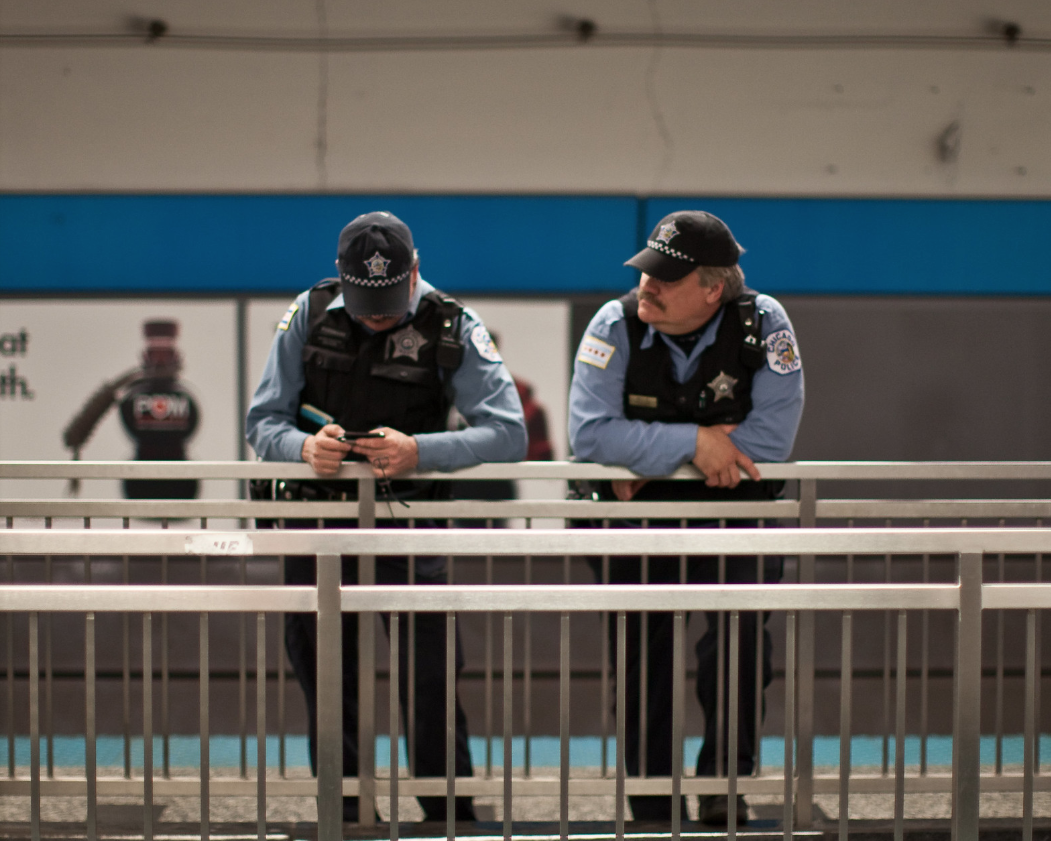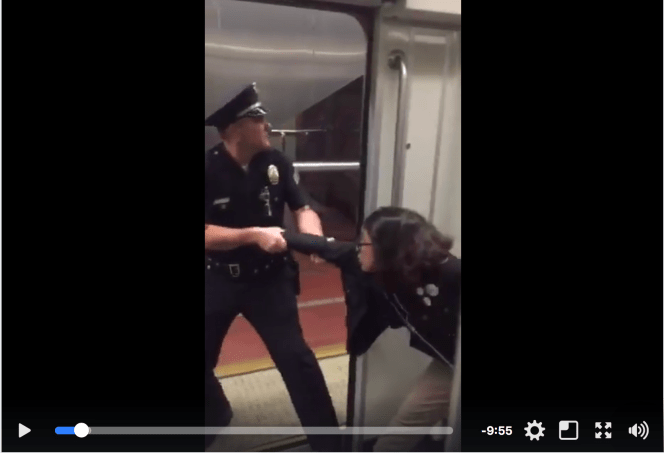Lightfoot announces plan for more transit policing, but LA’s experience is a cautionary tale
4:31 PM CST on February 28, 2020

Photo: Brian Hagy
Update 2/28/20, 5:00 PM: Shortly after this post was published, news outlets reported that Chicago police shot a man at the CTA's Grand Red Line station.
While violent crime can happen anywhere in public space, many Chicagoans are understandably alarmed about the recent wave of violence on the CTA. Since Thanksgiving, there have been many violent robberies on the 'L', and several high-profile assault cases. These include the brutal stabbing of a musician on the Jackson Red platform on February 4; the shooting of a man on the Blue Line near the UIC/Halsted stop on February 5; and the fatal shooting of Edward Charleston, 24, on February 17 in the tunnel between the Jackson Red and Blue platforms.
According to an NBC Chicago report, there had been at least 45 robberies on CTA platforms, buses, and trains this year as of February 1, and last year, there were 591 robberies on CTA property, the most in five years. A recent Chicago Tribune analysis of CPD data found that the number serious crimes — ranging from pickpocketing to robbery and sexual assaults — on the ‘L’ has doubled since 2015.
So clearly Mayor Lori Lightfoot had to do something to reassure Chicagoans that she's taking the issue of public safety on public transit seriously. The question is, what is the best approach, which will result in a net increase in safety and comfort for all CTA customers, in a city that has well-documented issues with police misconduct?
Today Lightfoot announced her public transit safety plan, which calls for adding adding 50 more officers to the Chicago Police Department's public transportation unit, "smart policing technology," and dedicating four detectives to solving crimes on transit. The 50 new officers will be in addition to several hundred officers currently patrolling the CTA.
“Public transit is the great connector of our city, and residents and riders deserve a world-class public transportation system that is not only accessible, reliable and affordable, but most importantly safe,” said Lightfoot said in a statement. “With these new public safety investments, we are building on our 'all-hands-on-deck' public safety strategy to maximize resources and expand manpower as well as increase cross-agency coordination to create real, widespread and lasting public safety.”
"The safety and security of the traveling public are extremely important to us," said interim police chief Charlie Beck, who came to Chicago after leading the Los Angeles Police Department, which is credited with helping bringing crime down 17 percent over the past five years on the LA Metro train and bus system. "Today's transit safety enhancements puts Chicago in alignment with other major city transit systems across the country and allows us to leverage technology-based policing that has helped reduce crime and violence in Chicago for the last three years."
The CPD will also be adding a new Strategic Decision Support Center to the 1st District headquarters at 18th and State streets, which will be used for solving CTA crime as well as other crimes in the district. Slated to launch this spring, the center will have access to more than 32,000 surveillance cameras already installed on CTA property. The SDSC room was funded by a donation from Republican hedge fund billionaire Ken Griffin, Illinois' richest man.
According to the city's press release, the SDSC room will shorten the time needed to access surveillance footage from both CTA cameras as well as private security cameras, which in the past has taken detectives hours to retrieve. "These district-based intelligence centers give real-time access to district intelligence information to police officers in the field, helping them determine deployment strategies based on historical crime data. This mobile technology will allow for smarter, data-driven patrols and significantly decreased response times to potential service calls."
In addition to the strategies announced today, Beck has already deployed SWAT officers in green uniforms on the 'L'.
Arguably, in the wake of the recently violent crime headlines, Lightfoot had no choice but to add more police to the CTA. However, it's worth noting that New York City has seen massive protests after a saturation-policing strategy to reduce fare evasion resulted in widespread arrests of low-income people of color for nonpayment, as well as crackdowns on other minor infractions. For example, in high-profile cases last November, officers on transit patrol detained and/or handcuffed two different Latina churro vendors.
A recent Sun-Times editorial mentioned Beck's home city of LA as a best practice. In addition to the overall 17 percent crime drop on Metro, that transit agency said robbery and assault have fallen 23 percent since 2015, and less serious crimes declined by 11 percent.
Metro officials credited the drop in crime to a 2017 policing plan that brought in officers from LAPD, the country sheriff's department, the Long Beach Police Department, private security firms, and the agency’s own police, including uniformed officers to enforce fare payment.
However, Sahra Sulaiman, Boyle Heights and South Central communities editor for Streetsblog LA, who has closely tracked Metro public safety issues, said that Chicagoans should take the reports of successful transit crime reduction with a grain of salt. She argued that the additional policing has involved the criminalization of poverty, potential civil rights violations, and heavy-handed enforcement tactics that have actually made many Black and Latino transit riders feel less safe.
"One of the things I harp on are the questions of 'Safety for whom?' and 'What kind of safety?'" Sulaiman said. "There was no discussion of what Metro viewed as safety or how it wanted its trains policed prior to the [policing] contract approval. It assumed the police would know what to do and how to do it."
Sulaiman noted that data released as part of an inquiry into possible civil rights violations by Metro showed that while African Americans made up only about 19 percent of rail ridership, they represented almost 60 percent of arrests. "The fact that the percentage of Black and brown folks arrested on transit has remained both rather consistent over the years and so disproportionate to their ridership numbers suggests that we’re criminalizing poverty."

Sulaiman said the over-policing of Metro has manifested itself in several high-profile cases, from a teen who refused to take her foot off a seat being dragged off a railcar by an officer and cuffed, to a young man who was tackled by police after being stopped for nonpayment, which led to him being crushed by an incoming train. (In the wake of that death, Metro switched to using "transit security officers" who are supposed to do the fare-checking to put a buffer between riders and police.)
On a day-to-day basis, Sulaiman said, officers have been staking out transit station plazas and chasing away skateboarders, timing patrols to coincide with school hours, boarding trains at every other stop, and "aggressively demanding TAP cards from folks of color" while in plain clothes. "It all feels like criminalization and intimidation."
So while adding more police to the CTA may have been inevitable, the experiences in New York and LA suggest that it's going to be crucial for them to stay focused on preventing and addressing serious crimes, not cracking down on fare evasion and other relatively minor infractions. If the additional patrolling is perceived as unfairly criminalizing poor people or singling out residents of color, there's sure to be a backlash.
In addition to editing Streetsblog Chicago, John writes about transportation and other topics for additional local publications. A Chicagoan since 1989, he enjoys exploring the city on foot, bike, bus, and 'L' train.
Read More:
Stay in touch
Sign up for our free newsletter
More from Streetsblog Chicago
Which Metra corridor would become more bike-friendly and greener under a new plan? Ravenswood!
Thanks to plans to convert little-used parking spaces, the avenue is slated to get a new bike lane, and the Winnslie Parkway path and garden will be extended south.
They can drive 25: At committee meeting residents, panelist support lowering Chicago’s default speed limit
While there's no ordinance yet, the next steps are to draft one, take a committee vote and, if it passes, put it before the full City Council.
One agency to rule them all: Advocates are cautiously optimistic about proposed bill to combine the 4 Chicago area transit bureaus
The Active Transportation Alliance, Commuters Take Action, and Equiticity weigh in on the proposed legislation.



